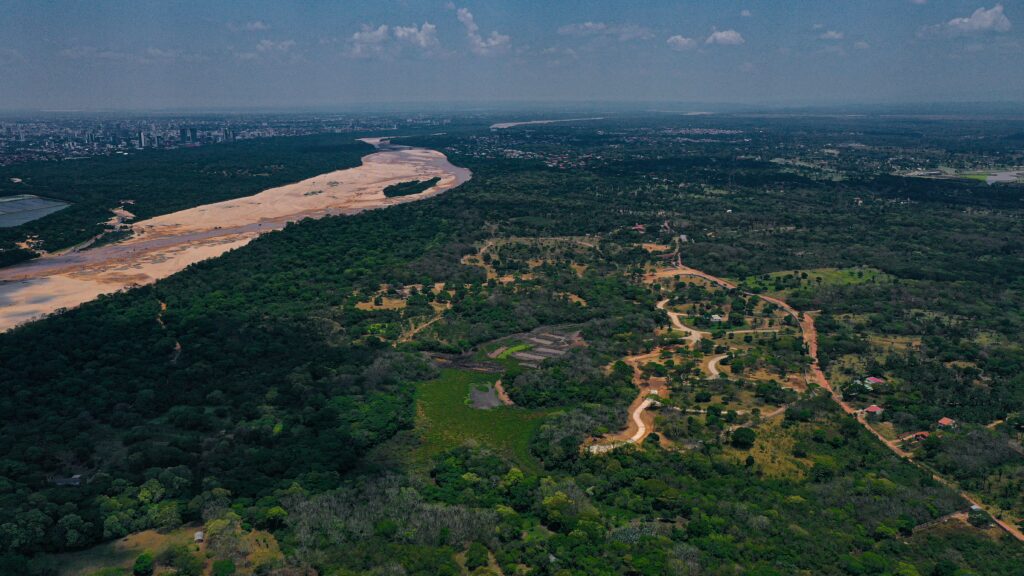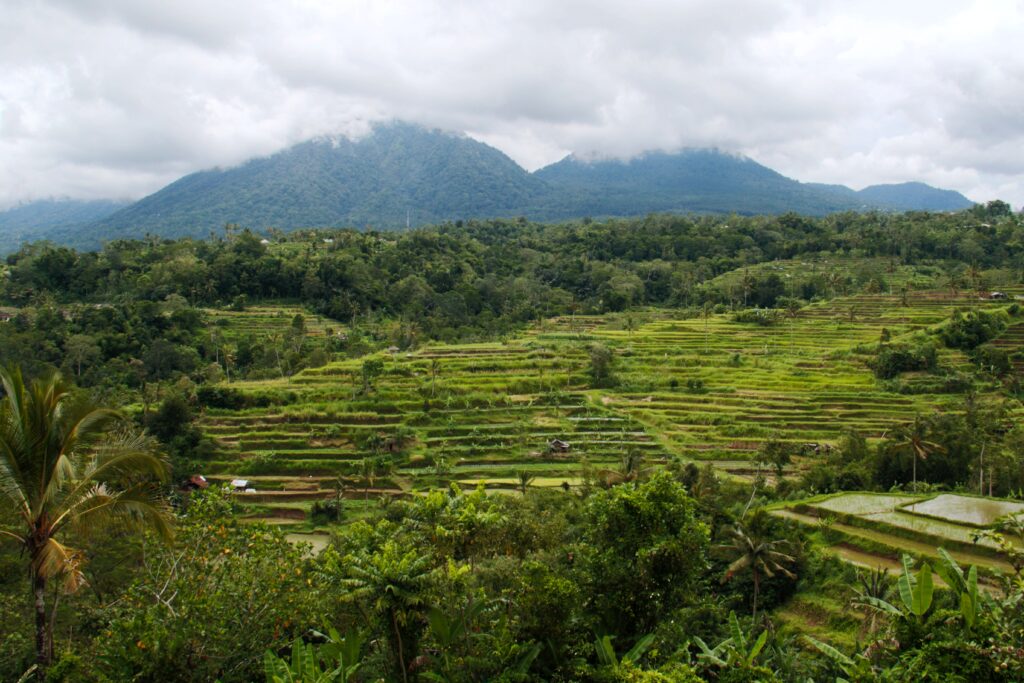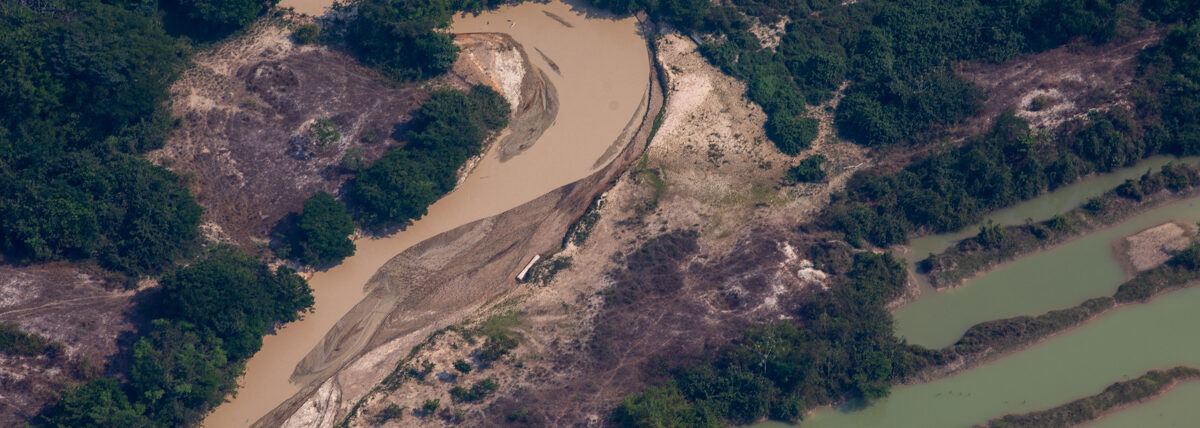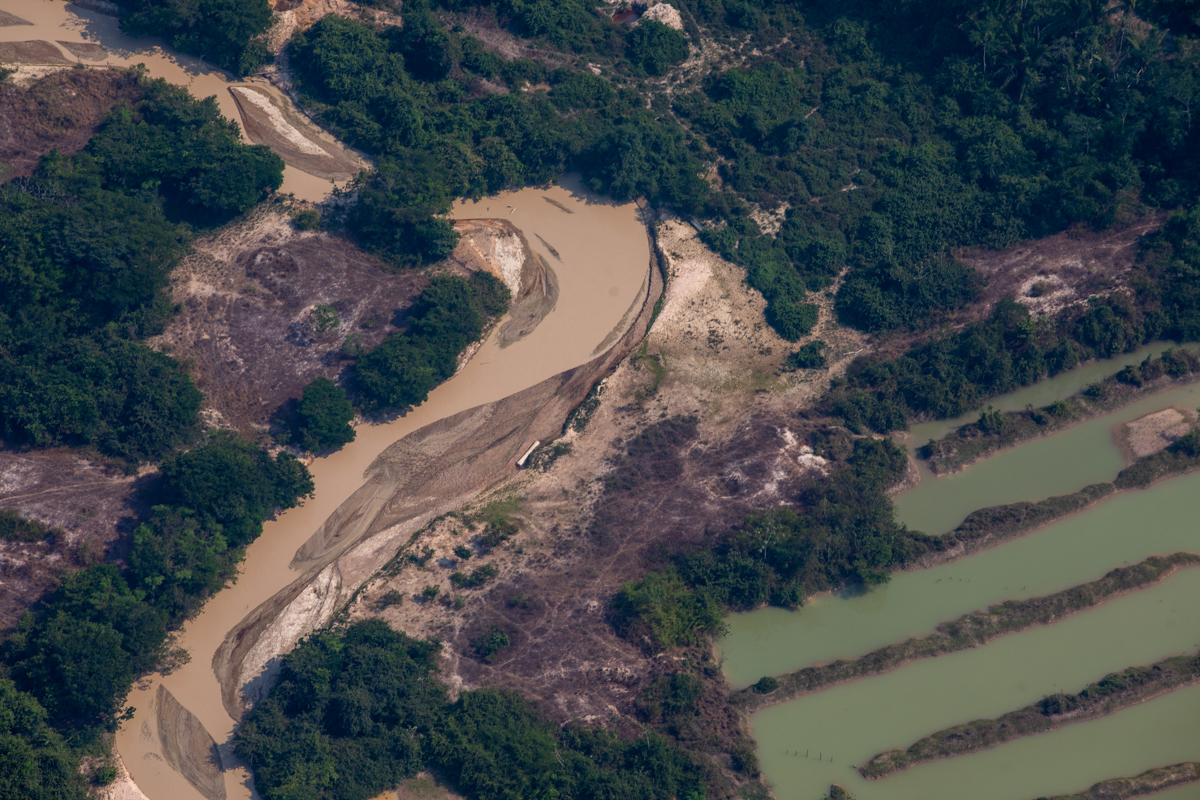Published: 03/13/2023
Photo of mining-driven deforestation in Brazil. Photo credit: João Laet
More than half of the world’s human population is threatened by vector-borne diseases—infections transmitted by organisms such as ticks and mosquitoes that result in hundreds of thousands of deaths a year globally. A new study from researchers at Stanford University, Griffith University, and the University of California Santa Barbara provides critical insights into the root causes of these diseases—and how we can think more systematically about solutions at a time when climatic and environmental changes are impacting their spread.
Research already shows that deforestation, mining, climate change, and other aspects of ecological degradation can impact infectious diseases by making conditions more favorable to disease-transmitting arthropods. Warmer temperatures, for example, can expand the ranges of mosquitoes and ticks. Open pools of water left by mining operations can serve as insect breeding grounds.
These relationships can be complex and affect diseases differently. In this new study, published in Nature Sustainability, researchers compare how human pressures on the environment impact diseases differently by studying how the effects change based on diseases’ specific ecologies. Using methodologies such as machine learning, these scientists have laid a foundation for better understanding what diseases will emerge where and when.
We asked three Stanford scientists behind this paper—Associate Professor of Biology and Global Health Faculty Fellow Erin Mordecai and Mordecai Lab postdoctoral scholars Eloise Skinner and Caroline Glidden—about these critical new findings and their implications for global health.
*Caroline Glidden, Erin Mordecai, and colleagues have also recently developed two publications on predicting unrecognized hosts and vectors of a vector-borne disease called leishmaniasis, and how they relate to human impacts on the environment.
What are today’s biggest vector-borne disease risks, and who is most impacted? What worries you the most?
Eloise Skinner: Vector-borne diseases already constitute a sixth of the total global burden of disease. As they emerge into new areas, driven largely by environmental changes, new, often-unprepared populations can be made vulnerable. In recent decades, we have seen the rise of vector-borne diseases in places we weren’t expecting: Zika in South America, Japanese encephalitis in Australia, West Nile virus in North America, and malaria in Europe. On the whole, the people most impacted are those in under-resourced communities—and that worries me most.
Caroline Glidden: In addition to lower-income populations, the people most at risk are those at the front lines of environmental change in sub-tropical and tropical areas. These communities often have limited public health resources—but also often hold knowledge and experiences critical to understanding these diseases. However, their perspectives are undervalued, unrecognized, and often neglected in public health research and management, significantly hindering our ability to understand and manage vector-borne disease emergence and spread.
Why is it so hard to predict the emergence of vector-borne infectious diseases? What are the ecological and social variables at play? And how does your research help to fill some of these gaps?
Erin Mordecai: Vector-borne diseases are complex and nonlinear. That means that a change in a particular aspect of the environment—like a one-degree change in temperature in a given year—does not necessarily lead to a straightforward, consistent, universal response in the disease. This may lead us to think that we can’t possibly predict when and where diseases will emerge and spread, but that’s not the case. We understand a lot about how forces like temperature, rainfall, human behavior, immunity, reservoir host dynamics, and others affect transmission. Yet, the process always has an element of randomness—we can’t say for sure when a new highly infectious variant will emerge or when a particular pathogen will get introduced into a particular population, for instance. Our work is all about capturing this duality—on one hand, that many of the features of the environment that drive disease transmission are predictable and have measurable impacts on disease spread; yet on the other hand, that the system is also inherently variable.
Eloise Skinner: It’s not just the environmental dynamics of disease that are complicated; we also have to consider complexities in the disease vectors themselves. Most people think that mosquitoes just emerge out of the swamps carrying all kinds of diseases—like a flying syringe. It is actually a lot more complicated (and interesting) than that. Mosquitoes have to bite an infected host before they can infect someone else. That means that for a disease to be transmitted, the mosquito has to be in a suitable environment that allows for it to reproduce, then feed on a particular individual that is carrying a virus or parasite, and then survive at least seven days (mosquitoes may only live 30 days in total) before going on to feed on someone else. So to accurately predict when and where these diseases are going to emerge requires a variety of data sources, and a deep understanding about the ecology of species, human behavior, immunology, and climate information.
Caroline Glidden: Some of my most recent work used machine learning and evolutionary and ecological traits of known Leishmania hosts to predict over 100 unrecognized hosts. Yet while scientists have developed the tools to better understand the transmission cycle of Leishmania—which causes a poverty-associated vector-borne disease—there is very little funding to research the ecology of the disease. This presents a major knowledge gap, especially since findings from this kind of research would help us to better understand disease spread in general and predict the emergence of novel vector-borne diseases.

How do human changes to the environment impact vector-borne disease? In your research, you’ve shown how this impact can change for different diseases. Could you say more about that?
Erin Mordecai: Virtually every aspect of the environment affects disease transmission, from the global climate system to the tiny microclimate effects we feel when we step from a sunny pavement into the cool shade under a tree; from large-scale infrastructure projects like roads and dams to the buckets and bottle caps lying around our yards. Vectors experience this environment in a very local, immediate way—it affects their life cycle, where they breed, how often and which species they bite, and their capacity to transmit pathogens. Our work has often examined these factors at a larger scale—for example, asking how large-scale changes in temperature impact the transmission of different pathogens by different vectors, and how different types of human pressure promote different vectors of disease. In this new research, we try to capture the nonlinear ways in which the environment affects the transmission process—through changing the abundance of hosts and vectors, changing contact rates between vectors and hosts, changing survival and development rates, and changing the capacity of vectors to become infectious.
Eloise Skinner: The challenge with looking at human impacts on land is that satellite data can only really detect when land is being converted—for example, forest being converted into agricultural land—but can’t clue us into how humans impact the health of an ecosystem. Our research provides new methodologies for evaluating human impacts on the environment—something that’s relevant not only to understanding disease transmission, but also conservation and other key environmental questions.
How can we leverage your latest findings to understand what interventions can best mitigate vector-borne disease?
Erin Mordecai: It is a long road to go from hypothesis-generating work like ours to ecological interventions and solutions, but our research suggests that there is a clear tie between the environmental and economic policies that govern land use decisions and human health outcomes. We can use quantitative methods like those in our work to capture relationships between environmental change, including temperature and human pressure as well as changes in habitat, and disease cases. With that evidence in hand, we can shape environmental policy to protect not only biodiversity and minimally-disrupted ecosystems but also human wellbeing in the form of sustainable livelihoods and protection against disease.
Caroline Glidden: As different diseases require different interventions and treatments, healthcare systems should be dynamic and managed at the rate of change of the human footprint. However, restructuring healthcare systems also comes with huge complexities and challenges.

What lessons from the study of vector-borne diseases and the environment can be applied to addressing pandemic concerns around spillover diseases from animals to humans?
Erin Mordecai: Emerging infectious diseases, whether they are transmitted by vectors or spillover from reservoir hosts, are inherently ecological. For humans to become infected, we have to be: spending time in places with infectious vectors or hosts; coming in contact with them through biting, shedding, or consumption; and susceptible to infection, which can be compounded by other environmental and health exposures. Disease transmission is a complex and multi-layered process that can be better understood and even predicted by dissecting those layers. What drives the distribution of the host or vector? What conditions promote contact between infectious and susceptible hosts? What social, environmental, and economic vulnerabilities increase people’s risk of exposure to novel pathogens? These are all factors that can be measured and incorporated into models that capture the many biological and social processes underlying disease spread.

